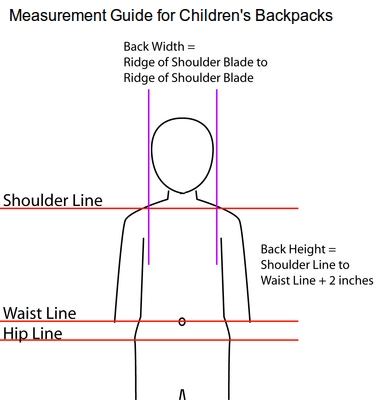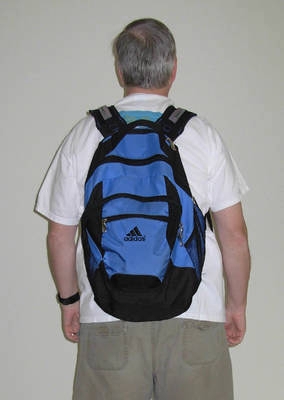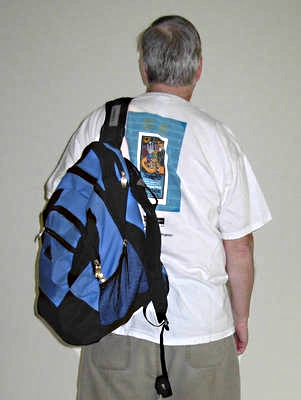Guide to Choosing the Right Kids Backpack and Avoiding Back Injuries

Image: Public Domain: Backpacks that are too heavy, are the wrong size or that are worn improperly can damage kid's backs
Improper choice of a poorly-designed and fitted school backpacks, overloading and improper strap tightening and misuse issues can risk back pain, discomfort and permanent injury for children and teenagers. Backpacks are often severely overloaded with kids carrying up to 22% of their body weight. Many children wear their backpacks for 30-60 minutes every day and the common habit of slinging the backpack over only one shoulder can cause permanent damage to the spine. This article outlines how to measure your child so that you can choose a backpack suited to their dimensions. It also summarizes the advice on how to fit and wear backpacks and maximum recommended loads to minimize injuries and back pain.
Can Backpacks Cause Pain, Injuries and Permanent Damage to Children?
Research has shown that in incidence of back pain in children is getting worse and this is correlated with increases in average backpack loads. A study conducted in 2011 study showed that the incidence of back pain for children of various ages were:
- Children aged 9 years back pain reported for 33%
- Children aged 13 years back pain reported for 28%
- Children aged 15 years back pain reported for 48%
Are Children Carrying Too Much Weight in their Backpacks?
A study of 1,400 Spanish students aged 12 to 17, conducted in 2012 highlighted the heavy loads being carried by most school kids
- 60% of children carried packs weighing more than 10 % of their body weight
- 20% of children carried packs weighing more than 15 % of their body weight
- 25% of children reported they had experienced back pain, with higher rates in girls than boys
- Incidence of back pain was higher in older students, implying that the damage caused by backpacks accumulated and worsened as children got older. Or perhaps older students were carrying larger backpacks
More than 9,500 patients treated in hospitals and by doctors for backpack-related injuries 2012 were school aged children (5-18 years old). This was 40% of the 24,000 people treated for these injuries.
Are Children Not Wearing Their Backpacks Properly?
Most back pain seems to occur when backpack shoulder and waist or hip straps are not tightened properly so that the weight of the backpack tends to pull the children's shoulders and upper body backwards. This means that they have to fight against this pulling action. Often children can be seen leaning forward or arching their backs to balance their packs which are acting as outriggers pulling them backward. When a backpack is properly fitted and the straps are tightened, the weight of the bag is borne vertically. Sudden movements when the child is walking or going up of down steps can cause jerking and twisting motions that can damage backs. The more the backpack is positioned away from the bag the more the pivoting effect of the backpack is accentuated. Wearing backpacks over only one shoulder does the same thing and causes twisting and strain on the back and spine.
How to Choose the Right backpack for Your Child?
Parents should buy a backpack that's an appropriate size for the child. See the measurement guide and how averages sizes vary with age. Parents should tell their kids to let them know anytime the child feels tingling or numbness in the arms or legs, which may be an early warning sign that the pack is too heavy or is not being worn properly.

Image: Public Domain: Key Measurements for Fitting Backpacks
Average Measurements for Children of Various Ages
Age |
Height(in) |
Width(in) |
Height(cm) |
Width(cm) |
4 |
11.0 |
6.0 |
23.3 |
12.7 |
5 |
12.0 |
10.6 |
25.4 |
22.4 |
6 |
12.5 |
12.7 |
26.5 |
26.9 |
7 |
13.0 |
14.8 |
27.5 |
31.4 |
8 |
14.0 |
16.9 |
29.6 |
35.8 |
9 |
14.5 |
19.1 |
30.7 |
40.3 |
10 |
15.0 |
21.2 |
31.8 |
44.8 |
11 |
15.5 |
23.3 |
32.8 |
49.3 |
12 |
15.5 |
25.4 |
32.8 |
53.8 |
13 |
15.5 |
27.5 |
32.8 |
58.2 |
14 |
17.0 |
29.6 |
36.0 |
62.7 |
15 |
17.5 |
31.8 |
37.0 |
67.2 |
16 |
18.0 |
33.9 |
38.1 |
71.7 |
17 |
19.0 |
36.0 |
40.2 |
76.2 |
18 |
19.0 |
38.1 |
40.2 |
80.6 |
Tips for Choosing and Backpack and Wearing it Properly
- Watch your child when they put their backpack onto their back to see if they struggle with the weight. If the pack appears to be too heavy work with. If a backpack appears too heavy, have the child remove some of the books and carry them in their arms to ease the load on their back.
- Choose a sturdy and very lightweight backpack. The pack itself should not weight more than 10-12% of the body weight of the child. Check the weight of the backpacks in the store and compare it with the weight of the child.
- The padded and adjustable shoulder straps should be at least 2 inches wide (6 cm). the straps should be very comfortable and snug on the shoulders of the child.
- Always try putting the backpack on your child to make sure its dimensions are correct for your child. The base of the pack should be no lower than the top of the hip bone. The top of the pack should be no higher than the shoulders. Look for a pack with padding at back where it rests against the body.
- Choose a pack with a waist belt or hip strap as this ensures the pack is pulled in against the body and does not lean out and cause strain.
- When lifting backpacks, make sure the child always bends at the knees and minimizes the twisting involved in fitting the backpack.
- Check the child's backpack regularly and keep working on the child so that they only carry what is absolutely necessary for that day. Excess items can be left at home or in their school lockers. It is very easy for the child to develop bad habits and not to sort and rationalize their backpacks every day.
- Backpacks need to be packed properly to distribute the load so most of the weight is positioned against the child's back. Ensure the child knows the optimal placement. Heavier and more bulky items should be placed in the center of the backpack, towards the bottom and not shoved into the top at the last minute.
- Encourage your child to readjust the straps every time they put it on. The load and what is carried changes and so adjustments are needed.
- Don't let your child carry their packs with a strap only over one shoulder. This causes twisting of the spine and can lead to temporary of permanent injuries
- If your child experiences any pain consult your doctor or a chiropractor. Take the backpack with you and have it checked out if this is likely to be the cause of the problem.
Correct Fitting on the Back

Image: Public Domain: Backpack Too Low on the Back

Image: Public Domain: Backpack Correctly Positioned on the Back

Image: Public Domain: Slinging the backpack over only one shoulder is an injury risk